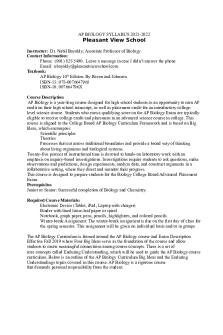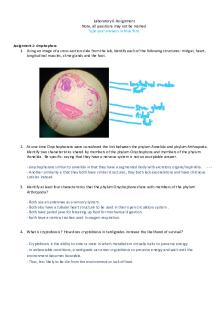Catalase lab biology 2021 pdf Gupta l PDF

| Title | Catalase lab biology 2021 pdf Gupta l |
|---|---|
| Author | BLAKE BUTLER |
| Course | Molecular Cell Biology |
| Institution | Saint Mary's College |
| Pages | 3 |
| File Size | 299.9 KB |
| File Type | |
| Total Downloads | 23 |
| Total Views | 158 |
Summary
This is a paper for catalase lab 2021 in entry biology. It is a great lab for entry level biology students just stating this topic...
Description
Observing the enzyme CATALASE INTRODUCTION: what would happen to your cells if they made a poisonous chemical? You might think that they would die. In fact, your cells are always making poisonous chemicals. They do not die because your cells use enzymes to break down these poisonous chemicals into harmless substances. Enzymes are proteins that speed up the rate of reactions that would otherwise happen more slowly. The enzyme is not altered by the reaction. You have hundreds of different enzymes in each of your cells. Each of these enzymes is responsible for one particular reaction that occurs in the cell. In this lab, you will study an enzyme that is found in the cells of many living tissues. The name of the enzyme is catalase (KAT-uh-LAYSS); it speeds up a reaction which breaks down hydrogen peroxide, a toxic chemical, into 2 harmless substances--water and oxygen. The reaction is as follows: 2H2O2 ----> 2H2O + O2 This reaction is important to cells because hydrogen peroxide (H2O2) is produced as a byproduct of many normal cellular reactions. If the cells did not break down the hydrogen peroxide, they would be poisoned and die. PRELAB REVIEW: Before you begin this lab, review pH. Recall that pH is the measure of the acidity or alkalinity of a solution. An acidic solution has many hydrogen ions (H+) and a pH below 7. An alkaline, or basic, solution has very few hydrogen ions and a pH above 7. A neutral solution has a pH of 7. Recall that the substrate is the molecule that the enzyme acts on, and the products are the molecules produced by the reaction. Review why enzymes are reusable. Under certain conditions enzymes are denatured. An enzyme is denatured when the protein molecule loses its proper shape and cannot function. Some things that can denature an enzyme are high temperatures, extremes of pH, heavy metals, and alcohol. PRE-LAB PREP: (REMEMBER: NEVER ADD WATER TO ACID, ALWAYS ADD ACID TO WATER). 3% Hydrogen peroxide is what you buy in the grocery store. MATERIALS: 6 Test tubes and rack Test tube holder Thermometer Stirring rod pH paper
10-ml Graduated cylinder Straight-edged razor blade 3 beakers for water baths Forceps (tweezers)
40 ml 3% Hydrogen peroxide solution Potato
PROCEDURES AND ANALYSIS QUESTIONS Part I – PROCEDURE -- Control NOTE: Be sure to clean your stirring rod (and test tubes) between steps. 1. Place 2 ml of water the into two clean test tube 2. Add a small piece of raw potato to one of the test tube and boiled to the other test tube. Observe the activity and record your observatrions.
Throughout this investigation you will estimate the rate of the reaction (how rapidly the solution bubbles) on a scale of 0-5 (0=no reaction, 1=slow,...., 5= very fast). Assume that the reaction in step 2 proceeded at a rate of "4" and record the speed in DATA TABLE 1, DATA TABLE 2 and DATA TABLE 3
3. the bubbles; what gas is being released Oxygen 4. Recall that a reaction that absorbs heat is endothermic; a reaction that gives off heat is exothermic. Now, feel the temperature of the test tube with your hand. Has it gotten warmer or colder? Is the reaction endothermic or exothermic? Is Catalase Reusable? It stayed at room temperature Part II – PROCEDURE -- Effect of Temperature on Catalase Activity Catalase is present in many kinds of living tissues. You will now test for the presence of catalase in tissues other than liver. 5. Place 2 ml of hydrogen peroxide in each of 2 clean test tubes. To the first tube, add a small piece of raw potato. To the second tube ad a piece of boiled potato. As you add each test substance, record the reaction rate (0-5) for each tube in TABLE 1. 6. Which tissues contained catalase?
Raw potato
7. What is the "optimum" temperature for catalase? (This is the temperature at which the reaction proceeds fastest.) Room temperature 8. What will boiling do to an enzyme? Change its shape and slow it down 9. What is happening in the test tube? Bubbles formed 10. Why did the reaction not proceed at all at 100 deg.C? The temperature changed the shape Part III – PROCEDURE -- Effect of pH on Catalase Activity 11. Add 2 of acetic acid to two each of the clean test tube. Place the drop on pH paper. Record the pH of each solution in DATA TABLE 3. 12. Next, add a small piece of boiled potato to one of the test tube and raw potato to the second test tube. 13. Next, add 2 ml of hydrogen peroxide to each test tube. 14. Estimate the reaction rates (0-5) and record in DATA TABLE 3. 15. Does there appear to be a pH "optimum"? At what pH? No 16. What is the effect of low or high pH on enzyme activity? It slows down or speeds up the reaction
TABLE 1: Control with distilled water
Sample
Rate of Enzyme Activity 1/5
Raw Potato + water Small bubbles are formed 1/5 Boiled Potato + Water
Small bubbles formed 1/5
Releases oxygen
Releases oxygen
TABLE 2: Occurrence of Catalase -Temperature effect on Catalase Activity Temperature Rate of Enzyme Activity Boied potato + H2O2
Produced small bubbles 2.3/5 produced oxygen
Raw potato + H2O2
Produced bubbles 2/5 corroded and produced oxygen
TABLE 3: pH effect on Liver Activity pH 4 Boied potato + 2 mls of Acetic Acid + H2O2 Raw potato + 2 mls of Acetic Acid + H2O2
Rate of Enzyme Activity
One big bubble 1/5 became lighter in color
Many small bubbles 4/5 foamed on top of liquid...
Similar Free PDFs

Catalase test micro
- 1 Pages

Biology 150 2021
- 6 Pages

AP Biology Syllabus 2021
- 5 Pages

Pea plant lab - Biology lab
- 6 Pages

Biology DNA Lab lab answers
- 18 Pages

Biology Lab Assignment #1
- 1 Pages

Biology lab report
- 8 Pages

Biology Lab Review 8
- 2 Pages

Biology Lab Practical I
- 6 Pages

Cks exams PDF 2021 2021
- 12 Pages

L Brands strategic report pdf
- 22 Pages

zoology biology lab 6
- 6 Pages
Popular Institutions
- Tinajero National High School - Annex
- Politeknik Caltex Riau
- Yokohama City University
- SGT University
- University of Al-Qadisiyah
- Divine Word College of Vigan
- Techniek College Rotterdam
- Universidade de Santiago
- Universiti Teknologi MARA Cawangan Johor Kampus Pasir Gudang
- Poltekkes Kemenkes Yogyakarta
- Baguio City National High School
- Colegio san marcos
- preparatoria uno
- Centro de Bachillerato Tecnológico Industrial y de Servicios No. 107
- Dalian Maritime University
- Quang Trung Secondary School
- Colegio Tecnológico en Informática
- Corporación Regional de Educación Superior
- Grupo CEDVA
- Dar Al Uloom University
- Centro de Estudios Preuniversitarios de la Universidad Nacional de Ingeniería
- 上智大学
- Aakash International School, Nuna Majara
- San Felipe Neri Catholic School
- Kang Chiao International School - New Taipei City
- Misamis Occidental National High School
- Institución Educativa Escuela Normal Juan Ladrilleros
- Kolehiyo ng Pantukan
- Batanes State College
- Instituto Continental
- Sekolah Menengah Kejuruan Kesehatan Kaltara (Tarakan)
- Colegio de La Inmaculada Concepcion - Cebu



